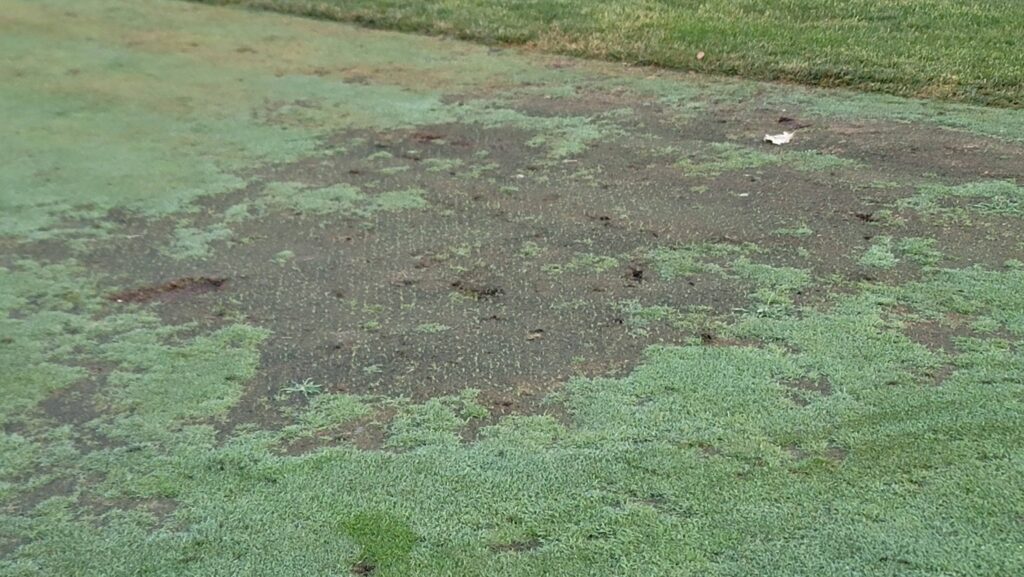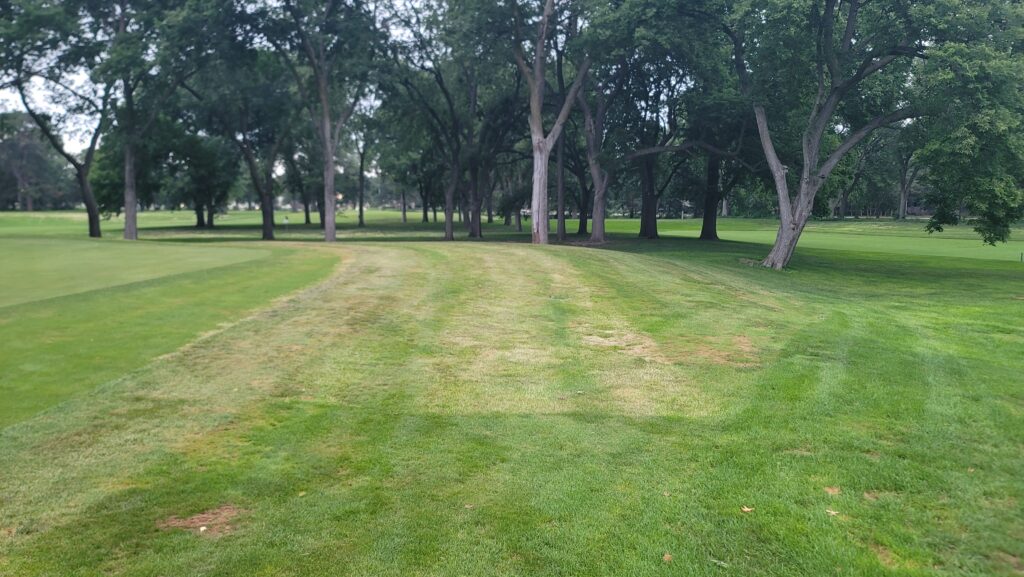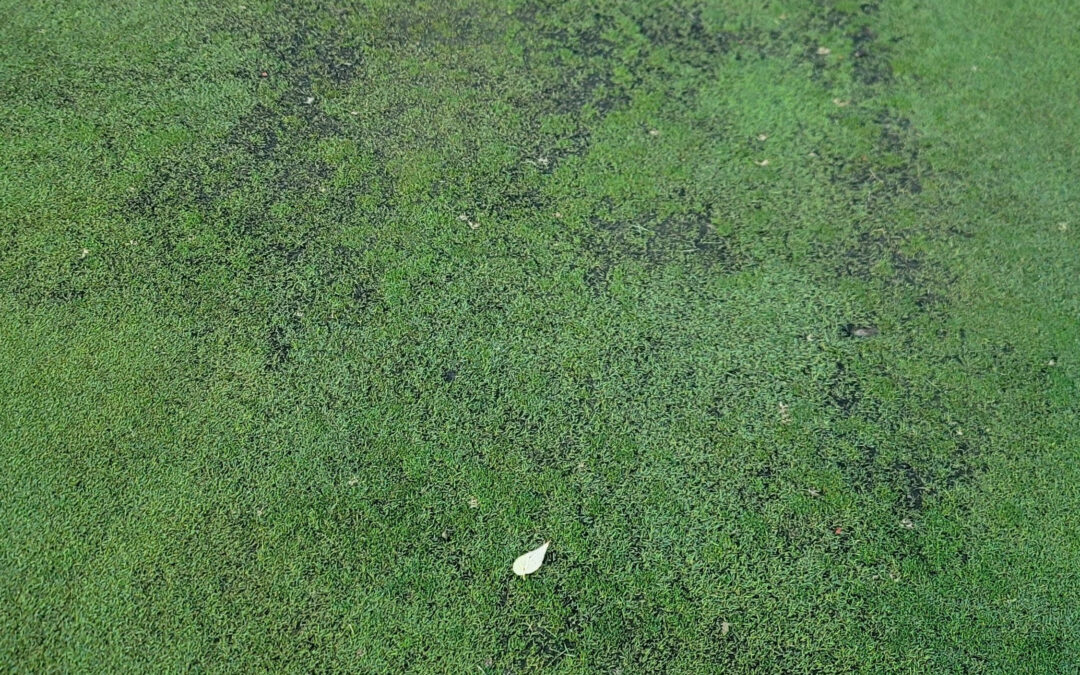It’s the middle August and many turfgrass plants are feeling as tired as their turfgrass managers. The recent extreme heat is taxing cool-season grasses like ryegrass, bluegrasses and bentgrass while summer weeds like goosegrass, foxtail and crabgrass are thriving. Diseases like Pythium blight and root rot, summer patch, and Anthracnose can quickly get out of hand, especially if over-irrigated. Extra stress from normal cultivation like sand topdressing or even rolling can lead to over-night turf loss. It’s mid-August and we are all holding on for the ride into fall weather.
Cool-season grasses are most efficient at making sugar via photosynthesis when the average air temperature is around 70 degrees Fahrenheit. While photosynthesis does decline at cooler temperatures, the sugar burn rate within the plant (respiration) also slows. It’s when temperatures start to exceed 70°F that things can quickly go downhill. Photosynthesis rapidly declines, especially above 85°F, while respiration accelerates. Additionally, mineralization of soil organic matter into nitrogen fertilizer by soil microbes increases at high soil temperatures. The added fertilizer promotes additional leaf growth/clipping yield. The bottom line: sugar use this time of year vastly outpaces sugar production. This weakens our cool-season turf grasses, and the slightest bit of stress can cause rapid stand decline.
This scenario plays out every single growing season. Turfgrass managers in the northern transition zone like Nebraska try to maximize sugar reserves in spring and minimize unnecessary sugar burn during the summer. Imagine the plant sugar reserves like a bank account. When times are good, it’s prudent to save money, but there is also flexibility to splurge occasionally. But when deposits slow down, it is then time to buckle down and limit unnecessary spending. For cool-season turf, the good times occur when temperatures range from 50-75F. Sugars are being created and the turf can recover from stress or more aggressive cultivation. The summer is different. The sugar reserves are in decline, and turf managers are trying to limit unnecessary sugar depletion.
Here are some recommendations to limit unnecessary sugar burn during hot August conditions:
Cultivation Moratorium
All forms of cultivation cause stress. Common maintenance practices like single- or double-mowing, rolling and light topdressing can be incredibly stressful on hot August mornings. Limit unnecessary cultivation until air temperatures are more conducive to cool-season turf growth. Avoid unnecessary mowing to limit stress and sustain sugar reserves.
Growth rate and fertilizer management Be frugal with nitrogen fertilizer application during high heat stress. While nitrogen fertilizer can help increase sugar production during cool weather, it can also stimulate excessive vertical/leaf growth when the weather is hot. Extra, unnecessary growth rapidly taxes sugar reserves.
Formally measuring growth rate, either by measuring the volume of clippings collected or by counting the number of days required between mowing, can help manage inputs of fertilizer or PGRs. If growth rate is well above normal, consider increasing PGR application rates to suppress the added growth.
Double Check Sprayer Math
It’s easy to be reactionary when turf quality starts to decline during intense heat stress. What can be applied to help improve or sustain turf health? While some products may help, it is also easy to rush and cause more issues. Be careful with sprayer math, double check product labels, and check for tank mix compatibility when mixing several products. A little tip burn from a “hot” tank mix may be well tolerated in June but could have disastrous consequences in late August.

Disease control
Weakened turf plants are more susceptible to disease and have less vigor to recover from a disease outbreak. Use good integrated pest management practices including precise irrigation management, scouting, and pest identification during heat stress. Be sure to use good rotation management when selecting pesticides. Most fungicide labels will have the rotation (FRAC) code somewhere on the front of the label.
Irrigation Management
Too much irrigation during hot and humid conditions can be just as hazardous as drought symptoms. Hot and wet soils quickly cause root decline, promote disease, can even lead to micronutrient deficiencies (especially Kentucky bluegrass and creeping bentgrass) when soil pH values are greater than 7.5. Rely on moisture sensors or feel the soil in your hand to decide if irrigation is needed. Remember, the effects of syringing to cool the turf is momentary and that turfgrass pathologists frequently run short (<5 min) overhead irrigation cycles to promote disease in their trials.
Be careful with herbicides
As air temperatures increase, the safety of some herbicides decline. Be sure to completely read the label before making an application or consider waiting until weather conditions improve.

Maximize airflow and minimize shade The best way to promote plant cooling is to promote evapotranspiration. When the heat index is much greater than the actual air temperature, natural perspiration (superintendents) and transpiration (turf plants) is hindered, and cooling is limited. Promote air flow to mix that humid air away from the turf leaves. Fans and parked blower cars running at low ideal can help move air and promote cooling in sheltered areas. In the long-term, prune trees and shrubs to increase airflow and reduce shade in fall.
Sometimes it is better to do nothing than something, especially when managing cool-season turfgrass during late summer heat. Mow to the one third rule, avoid excessive fertilizer or irrigation and withhold stressful cultural practices to stretch those sugar reserves as we move closer towards fall. And despite our best management, some turf won’t make it. At least we are getting into the fall seeding window to start recovering for next August.

